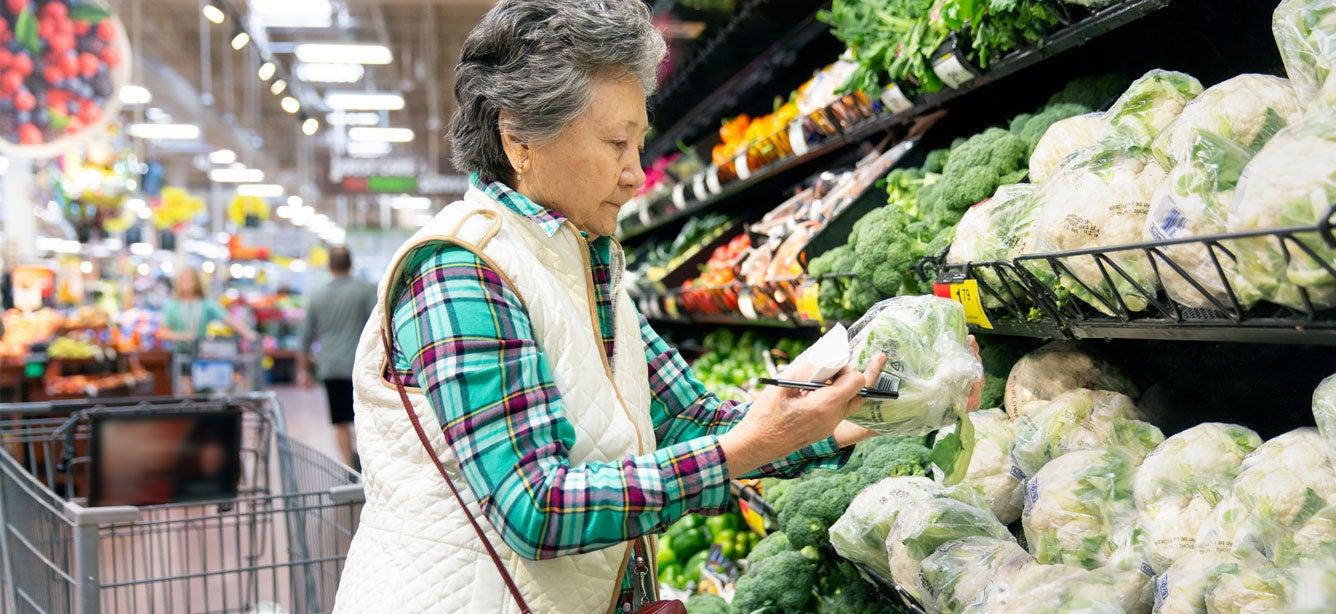
Related Topics
Supplemental Nutrition Assistance Program (SNAP) benefits can be used at most grocery stores, convenience stores, and even farmer’s markets to buy a variety of fresh, healthy foods. But SNAP doesn’t cover everything.
If you’re reading this article, you may want to know, “What can I buy with SNAP benefits?”
Whether you’re new to SNAP or you need a refresher, this handy guide will help you understand what you can buy with food stamps—and where you can make your purchases.
What can SNAP benefits be used for?
Since the SNAP program intends to “provide nutrition benefits to supplement the food budget of needy families so they can purchase healthy food and move towards self-sufficiency”,1 a good rule of thumb is to eliminate all non-food items, as well as food not meant for humans, from your shopping list. However: it's important to know what's considered “food.”
Here’s a list of what you can and can’t buy with your SNAP electronic benefits transfer (EBT) card. The green check ✅ - means yes, you can use SNAP benefits. The red X ❌ - means no, you can't use SNAP benefits.
✅ Staple foods
Most edible items you would commonly purchase at the supermarket qualify. These include:
- Fruits and vegetables (fresh, frozen, or canned)
- Meat, poultry, and fish (fresh, frozen, or canned)
- Dairy (fresh or shelf-stable)
- Bread and cereal
It’s important to note that SNAP is quite flexible with these four “staple food” categories.2 For example, nut-, soy-, and oat milk are allowable dairy substitutes; and gluten-free pasta qualifies under bread and cereal. You may even buy 100% apple sauce (considered fruit), eggs (poultry), or canned ravioli with tomato sauce (vegetable).
❌ Hot food / meals
You can’t use your SNAP benefits for food that’s hot at the point of sale, even if you’re in a grocery store. That’s because the program only covers “foods intended for home preparation and consumption.”3 This eliminates items such as rotisserie chicken, pre-cooked pizza slices, soup or chili from a prepared foods bar, and coffee or tea from a carafe. Cold sandwiches, salads, and other deli items do qualify for SNAP purchase if you’ll be taking them home to eat.
✅ Accessory foods
Speaking of home preparation and consumption: You can buy things like spices, oils, and sweeteners with your SNAP benefits.4 You may also purchase snacks, desserts, and certain beverages to complement the meals you make. These include, but are not limited to:
- Spices and seasonings (powdered, dried, or extracted)
- Honey, maple syrup, cane sugar, and other natural or artificial sweeteners
- Ketchup, mustard, and other condiments
- Potato chips, pretzels, popcorn, and other snacks
- Baked goods
- Cake and brownie mixes
- Ice cream
- Water, soda, lemonade, iced tea, fruit and vegetable juices, and certain energy drinks (drinks that are labeled as nutritional supplements do not qualify; see Pharmacy items below for more info)
❌ Beer, wine, and liquor
You can’t buy alcohol with SNAP benefits. This is true even if it’s available for purchase in a grocery store.
❌ Pet food
This is another “no” under SNAP guidelines. However, if there’s an animal companion in your life who might eat canned or bagged tuna, chicken, or other protein, there’s no rule against using your benefits to buy it and share it with your pet.
❌ Cigarettes
All tobacco products—including cigarettes, cigars, and chewing tobacco—are excluded under SNAP. And, although they technically do not contain tobacco, you can’t use your SNAP benefits card to buy e-cigarettes or refills, either.
❌ Pharmacy items
Any prescription or over-the-counter drug, vitamin, or supplement won’t qualify for purchase with SNAP (Medicare or Medicaid might cover these, though; be sure to check). And be careful with your beverage selections; certain sports and energy drinks won’t meet SNAP guidelines unless they include a Nutrition Facts label. Drinks with a Supplement Facts label only do not qualify.
❌ Personal care items
What about soap, deodorant, household cleaners, diapers, baby wipes, toothpaste, mouthwash, or makeup? Since none of these is considered food, SNAP won’t cover them.
✅ Seeds and plants
If you have the time, space, and ability to start a small garden, you may be happy to learn that you can use your SNAP benefits to do it. Under program guidelines, you can purchase seeds and plant starts that, over time, can prove to be more economical than buying produce in the store.
If you’d like to keep chickens in your yard, however, you can’t use SNAP to purchase them or the eggs they will hatch from. The program prohibits buying live animals except in the case of shellfish, other seafood, and animals slaughtered before you get them from the store.
Where can I use my SNAP benefits card?
Now that you know what you can buy with your SNAP benefits, you might want to know where you can buy it. The USDA sets strict participation rules for retailers. In order to be SNAP-authorized, a retailer must meet one of two basic eligibility standards relating to how much staple food they carry or how much staple food they sell.5 This means stores either must stock at least three different varieties of foods under each of the four staple categories—or that 50% or more of their gross sales come from items in one or more of the staple categories. Think “supermarkets” for the first category, and “butcher shop” or “fish market” for the second.
Many SNAP-authorized retailers post signs stating they accept food stamps; it’s always a good idea to look for it before filling your cart. Use the USDA’s SNAP Retailer Locator to check for SNAP-authorized stores. In the meantime, here’s a quick list of places where you can and can’t use SNAP:
✅ Grocery stores and supermarkets
Grocery stores almost always accept SNAP.
✅ Convenience stores
If your corner store carries enough staple food varieties, it should qualify for SNAP purchases.
✅ Farmers markets
Some farmers markets will even double the value of your benefits. Check with the market manager before you begin shopping to see if yours is one of them.
✅ Specialty food shops
As long as 50% or more of the items sold in the store are “staple foods,” you should be able to use your SNAP benefits to buy them.
✅ Online grocery delivery platforms
Finally, many retailers now allow you to use your SNAP EBT card online to purchase groceries for delivery and pickup. This includes major retailers like Walmart, Target, and Amazon as well as app-based food delivery platforms like Uber Eats and DoorDash. Learn more and see which of your favorite stores and delivery services accept EBT payments.
❌ Liquor stores
Liquor stores are not SNAP-authorized under either eligibility standard.
❓Restaurants and fast-food joints
Generally, you won’t be able to use SNAP for hot meals prepared in a restaurant for your immediate consumption. However, some states offer the SNAP Restaurants Meal Program for older adults, unhoused people, and/or people with disabilities. If your state is one of them, you can even get meals at “concessionary prices.”
I’m ready. How do I apply for SNAP?
Need help understanding your SNAP eligibility and how to apply? Get all the information you need at BenefitsCheckup.org. There, you’ll learn more about SNAP eligibility requirements and find your local program’s website. You can even get help applying for this and other benefits that can help you age well.
Sources
1. USDA. Supplemental Nutrition Assistance Program (SNAP). Found on the internet at https://www.fns.usda.gov/snap/supplemental-nutrition-assistance-program
2. USDA. SNAP Staple Foods. What Are Staple Foods? Found on the internet at https://www.fns.usda.gov/snap/retailer/staple-foods
3. USDA. Retailer Eligibility - Prepared Foods and Heated Foods. Found on the internet at https://www.fns.usda.gov/snap/retailer-eligibility-prepared-foods-and-heated-foods
4. USDA. SNAP Accessory Foods List. Found on the internet at https://www.fns.usda.gov/snap/retailer/accessory-foods
5. USDA. Retailer Eligibility - Clarification of Criterion A and Criterion B Requirements. Found on the internet at https://www.fns.usda.gov/snap/retailer-eligibility-clarification-of-criterion



